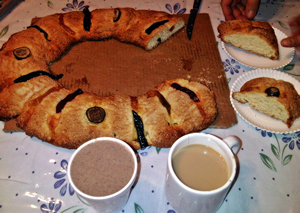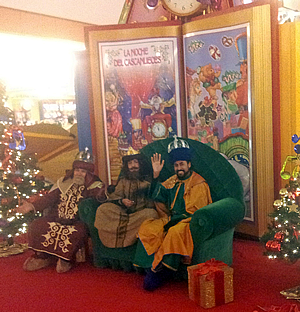Rosca De Reyes, Three Kings Day in Mexico
- Last Updated: January 14, 2013 by Al Barrus
- Categories:
- Christmas, Festivals / Events
While American students and teachers go back to work and study just after the first of January, the break lasts a bit longer south of the border. The phrase "Happy Holidays" isn't just to give political correctness to non-Christians; it can also refer to the handful of Catholic/National festivities in Mexico.
 This quasi-Catholic holiday the Epiphany, Three Kings Day, or as I know it, Rosca de Reyes, takes place each year on the 6th of January. It's to celebrate the arrival of the three wise men, magi or three kings as they are often called. The Rosca or Roscón is the name of a sort of ring-shaped fruit cake which is usually eaten with family.
This quasi-Catholic holiday the Epiphany, Three Kings Day, or as I know it, Rosca de Reyes, takes place each year on the 6th of January. It's to celebrate the arrival of the three wise men, magi or three kings as they are often called. The Rosca or Roscón is the name of a sort of ring-shaped fruit cake which is usually eaten with family.
I've been told that this tradition is also celebrated by Catholics and Lutherans north of the border, and also in New Orleans to kick of Marti Gras.
In Mexico it's quite obviously a national thing. Every grocery store has pallets of the pastries on sale during the first week of January. Traditionally it's circular, but bigger parties call for a bigger cake and thus it takes an oval shape.
It's not completely unlike the dreaded brick-like fruit cake of North American Christmas custom. There are the dried fruits; cherries, figs, and strips of candied fruit decorating the top. However, it's much less dense, and more enjoyable. It's comparable to sweet bread that you can find at Mexican bakeries state side.
 The three-kings theme isn't just limited to the cake either. During the holiday week between New Years and going back to school you can find wise-men specific holiday décor around. The most obvious being men at malls dressed in Middle-Easternish fancy garb, ready to pose like Santa or the Easter Bunny. That was a totally new thing for me.
The three-kings theme isn't just limited to the cake either. During the holiday week between New Years and going back to school you can find wise-men specific holiday décor around. The most obvious being men at malls dressed in Middle-Easternish fancy garb, ready to pose like Santa or the Easter Bunny. That was a totally new thing for me.
Something everybody talks about the day after the 6th of January is "did you get the baby Jesus?" That's because each Rosca de Reyes has a little white plastic representation of the child savior, which if you don't know to expect it could become a choking hazard. While dining with my extended family I bit into the plastic Christ this year.
By Mexican tradition, it means that I have to supply tamales on Groundhog Day. But why on the day of the weather-forecasting rodent? The 2nd of February is also an old Christian holiday that celebrates when the infant Jesus was presented at temple. This day is also called Candlemas or Día de la Candelaria. It's one of the 12 annual feasts in Catholic tradition, and marks the end of the Carnival or Marti Gras festivities.
Anyway, this whole 6th of January holiday was celebrated by the Romans before their conversion to Christianity. Back then it was called Saturnalia, and had to do with ringing in a new planting season since Saturn was the god of agriculture, and the rotation of the earth meant less darkness and so forth. The Romans had a hard time snuffing out the candles of this annual day, so they apparently changed the name.
To me, all the history doesn't really make a difference. What I like about Mexico is that there's little emphasis on the reasons behind celebrations, and more about just spending quality time with your loved ones.